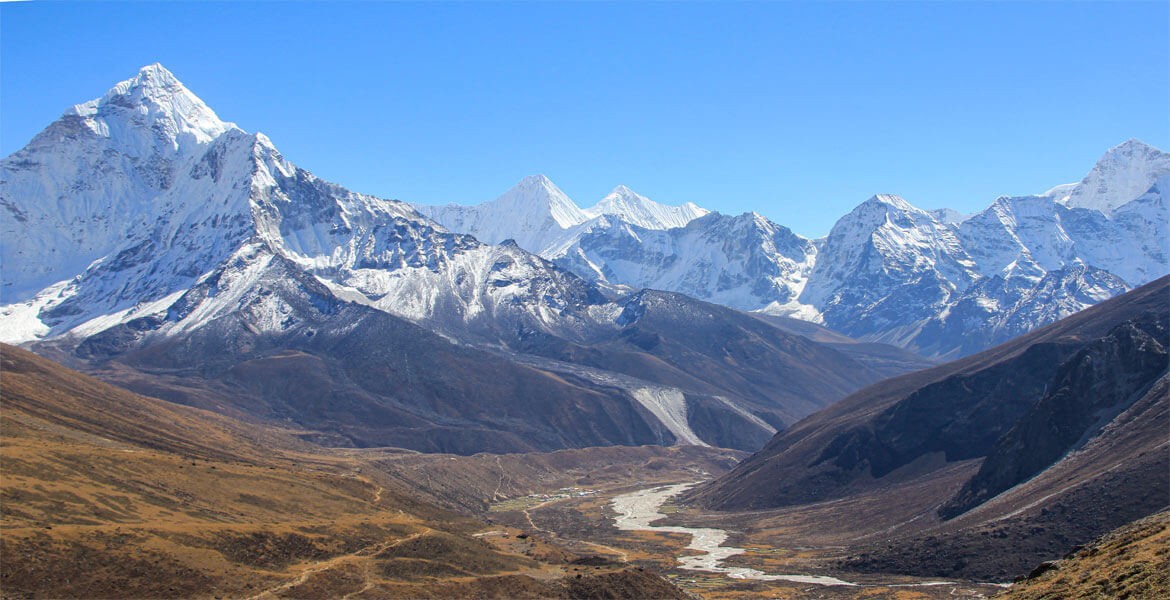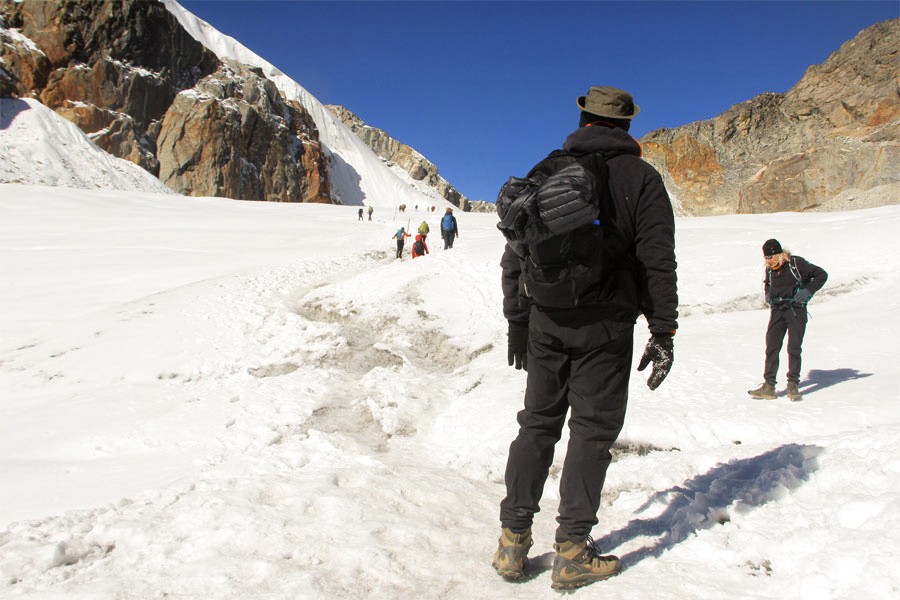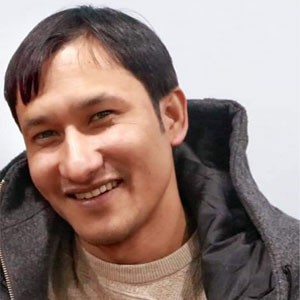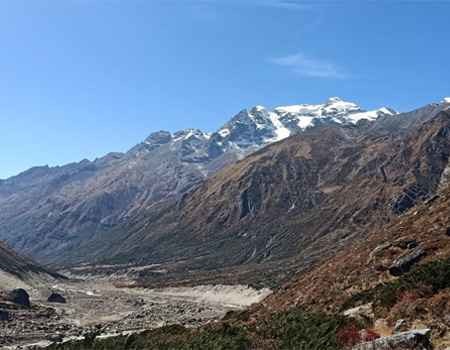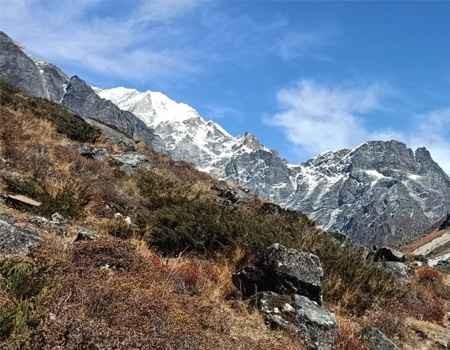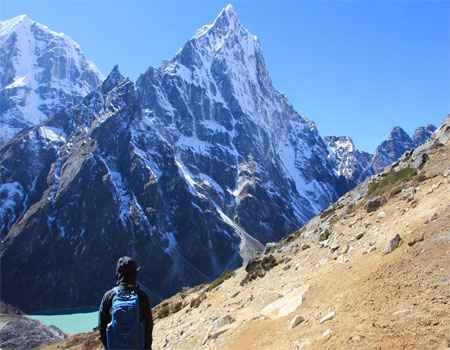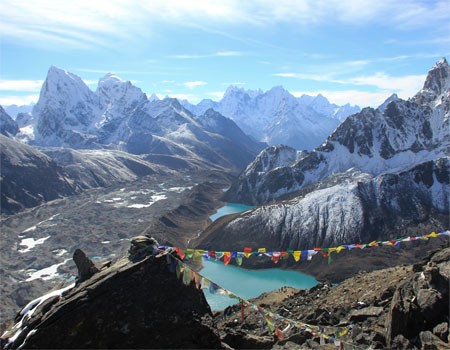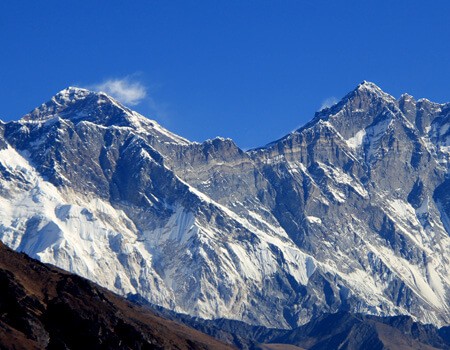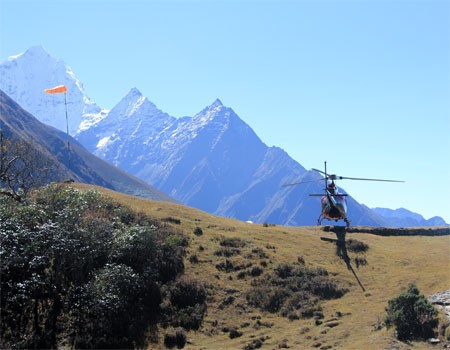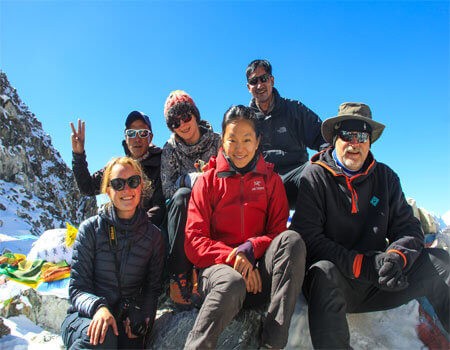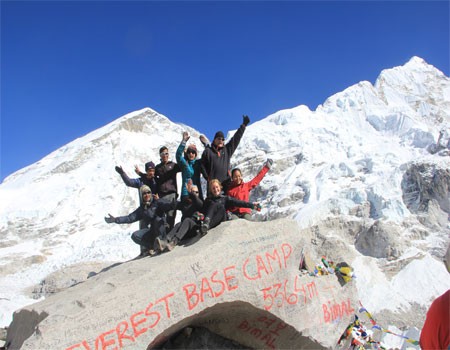It is essential to be clear about going over Cho La Pass and visiting the Everest Base Camp first or Gokyo Lakes. Many trekkers cross Cho La from both directions (clockwise and counter-clockwise). First of all, do you prefer a long hill climbing trail or one that is downhill? From my experience, many people like a shorter climb than a long one.
Everest Base Camp or Gokyo Lakes First Before Cho La Pass
Table of Contents
No doubt, the Everest Base Camp first and then Gokyo Lakes later via Cho La pass is more accessible for most trekkers if you are on the EBC Gokyo Trek in the Everest region. But, if you have knee problems walking long downhill, we suggest the Gokyo Lakes first. Visiting Gokyo Valley, or the base camp of the world's highest mountain, via Chola Pass is probably one of the best treks in the Everest region. It covers most of the beauties from the Khumbu region. But it would be best if you are adventurous enough to attempt this mountain trip because it is an adventure in the Himalayan journey in Nepal.
Why Cho La Pass is an Adventure Trek?
Typically, you have a pleasant and clear trekking trail if you are just on the base camp and Gokyo without a Cho La Pass. However, the path before and after Cho La is rough, with rocks and icy snow. Walking on this rough trail requires a lot of practice and physical fitness. Also, the altitude makes walking with low-level oxygen in the air challenging.
Besides physical stamina, the rough trail, icy parts, low oxygen, cold temperatures, and wind (if you reach the top late) also make the trip challenging. It is best to start walking early in the morning to cross over the Cho La to avoid the strong wind on the top, which might sometimes cause stones to fall on the trail while hiking.
You must start very early, especially if you are going over the pass from Thangnak from the Gokyo side in the dark with a flashlight. So, less oxygen, rocky path, ice, cold temperature, wind, and more factors make the trek adventurous.
First, Everest Base Camp, Then Gokyo Lakes
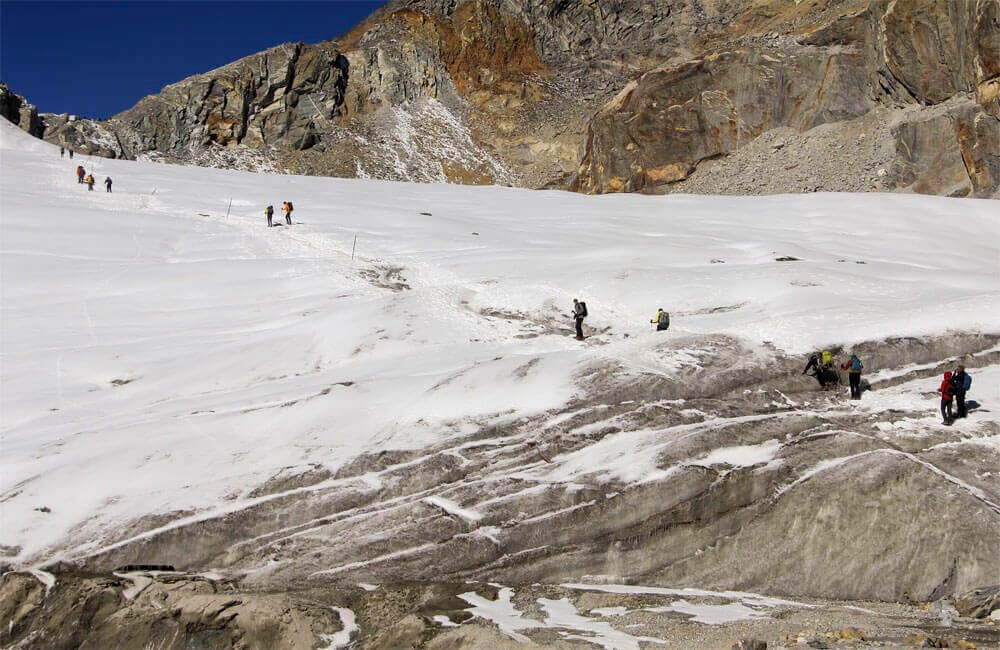
Near the top on the counterclockwise route
After the base camp visit from Lobuche, you spend a night in Gorakshep and then hike up to Kalapatthar before reaching Zongla (4830m) for the Cho La pass 5360m). Reaching the top takes around 3 hours, gaining about 500m elevation.
You do not need to start early from Zongla to the pass. However, if you are a slow trekker, we recommend starting at least half an hour earlier than other normal-faced trekkers. The trail on this side is more transparent and has less climbing, but you will walk about 200m on ice right before reaching the top. The ice does not start melting in the morning before the sun's heat, so walking upward from here will be less slippery if you go over Cho La from the Everest Base Camp side.
If there is snow, descending after the top will be challenging, but the iron rope has been fixed around the pass on both sides, so you can catch it while descending.
You will not miss a chance of reaching very close to the world's most incredible mountain if you visit the base camp first, even if you can not go over the Cho La, because most trekkers might have a primary goal of reaching the bottom of Everest at least once in their life.
Also, you have one more rest day on this route than the other one, so you will be well climatized before going over the high pass.
Also, you get sharing helicopter at a cheap cost to go to the base camp on this side to visit Kalapatthar if you have any problems earlier, can't walk further higher, and are willing to see the beauties of the Everest Himalayas from the close distance, the Base Camp first before going over Cho La makes your trek more meaningful.
Cho La Pass Counterclockwise Itinerary
After we provide information about the Counterclockwise route for the Cho La pass, you might be interested in the Trekking Itinerary. We have provided this here, which may make it easier to plan the trek.
Day 01: Fly to Lukla (2840m) and Trek to Phakding (2610m)
You fly early in the morning from Kathmandu to Lukla (30 minutes) or from the drive to Ramechhap (4 hours), then flee for about 20 minutes. After landing at Tenging-Hilary airport, you start walking toward Phakding, which is around a 3-hour journey on descending paths.
The trail descends to Chheplung until Thadokoshi River for about an hour and a half. Then, it ascends gradually after crossing a short metal bridge to the top of Ghat village. Then you trek about 45 minutes to Phakding.
Day 02: Trek to Namche Bazaar (3440m)
On the second day of the counterclockwise Everest Gokyo Lakes trek, you reach Namche Bazaar. The trek takes 6-7 hours and gains 700 m in elevation from Phakding to Namche. Today, you cross five different suspension bridges over the Dudhkoshi River. The walking trail mostly gradually ascends, but it is a steep climb to Namche Bazaar for the last two hours.
Day 03: Altitude practice rest in Namche Bazaar
It is not a proper rest day because you hike to Hotel Everest View for acclimatization before going further to higher elevations. The hike to Syangboche Hill will be about 2-3 hrs today. You see terrific views of Kusum Kangaroo, Thamserku, Khangteka, Amadablam, peak 38, Lhotse, Everest, Nuptse, and Taboche from right to left. The Everest View Hotel at Syangboche Hill is the highest luxury hotel in the world. You can have hot drinks seeing magnificent views of the mountains, valleys, and traditional Sherpa towns. The travelers on the EBC helicopter tour also land here for breakfast during their flight tour.
Today, you hike 400m from Namche Bazaar on an altitude practice hike. After visiting this place, you can walk back the same way or visit Khumjung village and take another route.
Day 04: Trek to Tengboche (3860m)
Today, you walk for about two and a half hours on a nice, clear, wide path from the top of Namche Bazaar to Kyanjuma. An older man you see while walking here collects donations from trekkers and maintains the trekking trail. You will also walk for about five to six hours, gaining about 400m elevation on several downhill and uphill paths.
Day 05: Trek to Dingboche (4410m)
It is about a 5-hour trekking day and ascends around 600m in elevation. You start the day by descending for half an hour to Dibuche and walking on a flat trail for another hour through the pine and rhododendron trees forest. Then, the trail ascends after the bridge and goes through Pangboche and Somare villages. Today, you always reach above the tree line and see open views.
Day 06: Second altitude practice rest day
It is your second altitude practice rest day in Dingboche. You hike Nangkar-Tshang peak after breakfast, which is 5100m plus height, so it is essential before going to the higher elevations. You see the two highest mountains above eight thousand meters (Makalu and Lhotse) with many high mountains. Mt. Ama Dablam looks amazingly attractive from this and looks very close during this altitude practice while you are on a counterclockwise trek for Cho La pass.
Day 07: Trek to Lobuche (4910m)
Today, you walk around 5-6 hrs to Lobuche with gaining 500m elevation. The day begins with a gradual ascend for around 20 minutes and goes on a pretty flat trail, keeping Pheriche Valley on your left. You cross Khumbu Khola right before reaching Thukla. Then, the course goes upward for another hour to the top of Thukla Pass, where you see many memorials of dead climbers. Then, the final hour trail goes on to the flat part of Lobuche.
Day 08: Trek to Gorakshep (5180m) and hike to EBC (6364m)
You start the day early compared to the other days from Lobuche because it is long. You trek to Gorakshep, taking 3 hours, stop for a quick lunch, and then hike to EBC. It will take 2-3 hours to reach the base camp from Gorakshep one way and then walk back, taking the same time to stay. There is no place to sleep at the base camp.
On Lobuche Pass, the trail initially goes flat and steeply ascends for about 15 minutes. After crossing this pass, you walk on a gradually ascending path, keeping the famous Khumbu glacier on the right. The trail to Gorakshep and EBC is rockier from here, with lots of up and downhill.
Day 09: Hike to Kalapatthar (5550m) and trek to Zongla (4830m)
Today, you hike Kalapatthar early in the morning, starting with a flashlight. You ascend 400m, and reaching the top takes around two hours. Kalapatthar is the best hill station to see the nearest glimpse of Mt.Everest, and it offers 360° high mountain views. After visiting this hill, you hike back to Gorakshep, have breakfast, and then trek to Zongla, passing through Lobuche, which takes around 4 hours.
Day 10: Trek to Gokyo (4790m) via Cho La pass (5360m)
Today is the most adventurous day during the -counterclockwise trek. You start walking early in the morning from Zongla, and the trail begins with a gradual ascend for about an hour. And then, you walk on a steep part for another hour before reaching the permanent icy area. The final position on the ice takes another half hour, which is relatively steep.
The altitude gains about 5 hours in 3 hours to the top from Zongla and then descends steeply on the rocky path, but there are stone steps and fixed rope. After crossing the steep part takes about an hour, you have a pretty flat area, but still, there are lots of rocks on the trail for another half an hour.
Now, you start ascending gradually for another hour and find it easy to descend at the end to Thangnak, where you stop for lunch. If you get tired from the Cho La pass and have more spare days in Nepal, you can stay overnight in Thangnak, where there are a few lodges.
After lunch and a long rest, you depart to Gokyo. Here, you cross a massive Ngozumpa glacier, which takes another two hours to Gokyo. You stay close to beautiful Gokyo Lake today and see a nice view from the dining room.
Day 11: Hike to Gokyo Ri (5360m) and trek to Dole (4110m)
Today, you hike to Gokyo Ri early in the morning, which takes around two hours on a steeply ascending trail. The trail here is steeper than the Kalapatthar, but the temperature is warmer, and it feels easier to breathe. This hill station shows the four highest mountains above eight thousand meters (Everest, Lhotse, Makalu, and Cho-Oyu) and many high, snow-capped mountains. Tranquil Gokyo lakes and glaciers look amazing.
After enjoying the great view, you hike back to the lodge, have breakfast, and trek to Dole through Machchhermo in the Gokyo Valley.
Day 12: Trek Back to Namche Bazaar (3440m)
Today, you are back in the tree line, so start the day descending through pine and rhododendron forests. In this forest, you might see musk deers, Himalayan Thar (wild mountain goats), and the Nepalese national bird (Himalayan Monal). After descending for around an hour, the trail goes upward to Mong Hill for two hours. The views of Ama Dablam and other mountains look amazing from this hill. Then, you descend gradually to Sanasa and stop for lunch in Kyanjuma. After lunch, you trek another two and a half hours on the lovely path to Namche Bazaar.
Day 13: Trek back to Lukla (2840m)
It is the last day of the long trek in the mountains. The trail ascends gradually to Lukla, which takes around seven hours to arrive. However, most of the trail descends. After walking for about four hours, you stop in Phakding for lunch and then trek for three more hours to Lukla.
Day 14: Fly out to Kathmandu or Ramechhap and then drive
You have a morning flight to Kathmandu or Ramechhap today. Lukla flights mainly operate from Ramechhap during the high seasons. Hence, you must drive for about four hours to Kathmandu from Ramechhap. However, some late flights still operate from the Kathmandu airport. If you want to fly directly to Kathmandu, you can take the late flight, but there will be a high chance of flight cancellations.
First Gokyo, Then Everest Base Camp for Cho La Pass
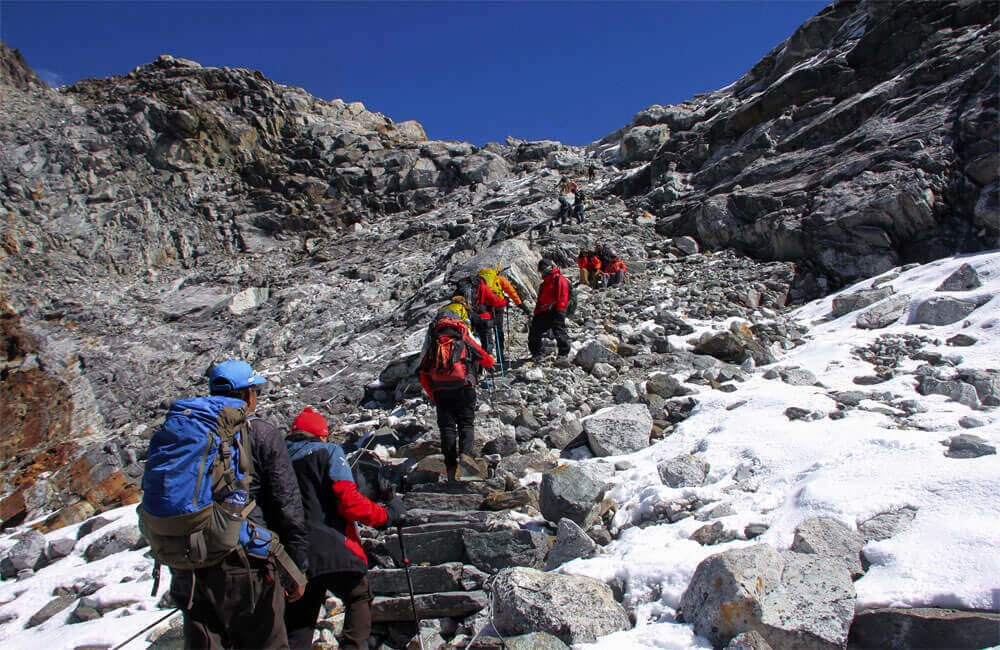
Before Cho La from the clockwise route
Is it challenging to cross Cho la, visiting the Gokyo Valley first before going to the Everest Base Camp? We say yes, because of the many hour's steep climb. It takes around 5 hrs to reach the top from Thangnak (4790m) to Chola (5360m), ascending about 600m with more steep, up-and-down rocky trails. What makes it challenging to go over the pass from the Gokyo side, then? Check them out here:
- It will be best if you start walking in the dark with a flashlight
- Tiring steep uphill trail and zigzag rocky paths
- Hard breathe while walking on a steep uphill
- Slipary downhill after the top with melted ice
Clockwise Gokyo Everest Base Camp Itinerary
After getting information about the counterclockwise itinerary above, you may want to see the Clockwise one for more info. Of course, we are providing this too here;
You stay with the counterclockwise trekking itinerary for the first three and the last two days, so here you can see details on the rest from the fourth to the eleventh day. The itinerary is one day shorter, so Let's go there now:
Day 04: Trek to Dole (4110m)
Today, you follow the same trail for about 3 hours, where all Everest base camp trekking trekkers will be walking. And then, you split to the left toward Mong Hill, walking on ascending trail for another hour and a half to two hours. Then, the trail descends to Phungki-Tenga for half an hour and climbs to Dole for the final two hours through a dense forest of rhododendrons and pine trees. You gain almost 700m in seven hours of a walk today.
Day 05: Trek to Machchhermo (4470m)
It is an easy and short trekking day. You walk for four hours, ascending 300m elevation, although the trail goes gradually uphill and downhill. You are above the tree line from today to see open mountain views of Taboche, Thamserku, Cholatse, and Nepal's fifth-highest mountain, Cho-Oyu.
Day 06: Trek to Gokyo (4790m)
Another short and accessible walking journey to Gokyo from Machchhermo takes about 3-4 hours and involves an elevation gain of almost 300m. Today, most of the trekking trail gradually goes uphill and is flat. You cross the first and second lakes and reach the third, where you will stay overnight.
Day 07: Hike to Gokyo Ri (5360m) and trek to Thangnak (4700m)
Today is the third short trekking day, but it is an adventure because you are climbing the Gokyo peak. After hiking for two hours to see stunning views in the morning, you hike back to the lodge and have breakfast. After breakfast, you head on to Thangnak, crossing the Ngozumpa glacier. Today, you walk for two hours.
Day 08: Going over Cho La pass (5360m) and trek to Lobuche (4910m)
It is the most adventurous and long day trek. You ascend more than 700m and descend 400m. It takes around five hours to get to the top from Thangnak to Cho La, so you must start an early morning in the dark with a flashlight.
The trail gradually ascends for two hours. It then descends to the rocky path for another hour and steeply ascends for the last two hours. Then, you start dropping to the other side, walking on ice for a while. It takes about two hours to reach Zongla. You stop here for lunch and have a long rest. If you are tired from Cho La and have plenty of time, you can stay here overnight or walk to Lobuche for another two hours.
You can see amazing views of Mt.Cholatse, Taboche, Amadabam, Khangteka, Thamserku, Lobuche Peak, and Nuptse on this side with beautiful Khumbu valley and a small tranquil lake at the bottom of Mt. Cholatse.
Day 09: Trek to Gorakshep (5180m) and hike to the EBC (5364m)
Today, you are reaching the foot of the world's highest mountain, which many people dream of visiting. You start early morning from here too, but later as before the Cho La. You walk three hours to Gorakshep. The day begins with a flat part, gradually ascending, and walks on the glacier with a rocky path before reaching Gorakshep.
Now, you have a quick lunch in Gorakshep and then hike to the Everet base camp. It takes two and a half hours to three hours (one way to EBC), and then it is the same to walk back because you must come to Gorakshep. There is no lodge where you can spend a night in the base camp.
Day 10: Hike to Kalapatthar (5550m) and Trek to Pangboche (3985m)
It is also an adventure day. You hike early in the morning with a flashlight for about two hours to Kalapatthar from Gorakshep. Seeing the nearest view of the world's highest mountain and 360° surrounding tall mountains, you hike back to Gorakshep, have breakfast, and then trek down to Pangboche through Lobuche, Thukla, and Pheriche. It is about a 5-6 hrs trekking day, excluding the Kalapatthar hike.
Day 11: Trek from Pangboche to Namche (3440m)
Today, you descend around 500m lower, walking several long down and up hills. However, you feel easy walking and breathing around this area and back in the trees' line again. After walking for about an hour, you have to ascend the trail to Tengboche Hill for about half an hour, and it goes a long descent to Phungki-Tenga. Now, you must steep the part again for an hour and a half to Sanasa, where the Gokyo Lakes route is divided. Then, walk the flat for another 2 hours and a half at the end before returning to Namche.
Days 12 and 13 will be clockwise itinerary stays, with days 13 and 14 being counterclockwise Everest Gokyo Lakes treks via Cho La pass.
More Information on Cho La Pass Trekking
Provided information with a detailed itinerary might not be enough information on Cho La Pass Trekking, so you probably have lots of curiosity about it, so we have tried to provide some essential information here:
Is there any Lodge or Teahouse between Zongla and Thangnak?
There is no one Teahouse between them, so you need to travel between places for lunch. However, you can arrive early in the morning at lunchtime from either side. We recommend taking energy bars or snacks for this high pass.
Also, you can not get any place to buy or refill drink water, so take enough drinking water with you. At least two liters of water taken for Cho La is highly recommended.
Is There Another Easier Way to Visit Base Camp and Gokyo Lakes?
There is a more leisurely walking route than going over the Cho La pass, but it takes about one day longer. If you take an accessible route, you must follow the same trail for several days. A path through Phortse village connects Pangboche to Dole or Pangboche.
Is Cho La Pass the Most Adventurous Trek in the Everest Region?
Of course, Chola is not easy, but it is not the Most Adventurous Trek in the Everest Region. It is one of the high passes of the Everest three hill crossing, so Kongma La is the hardest and highest one. The Everest 3-pass lodge trekking is the most adventurous in this Himalayan region.
Best Time to trek to EBC Gokyo via Cho La Pass
It stays closed chiefly during winter but is doable most of the time. Winter is challenging due to snow and cold temperatures. Summer is easy, but the views are poor because of rain and clouds.
Autumn is the best time for this trek because the weather conditions in the Everest region are more stable in October and November. During your autumn trek to the EBC Gokyo lakes via Cho La pass, you can see crystal mountain views and unfrozen Gokyo lakes. December also offers beautiful views, but the Khumbu region will freeze.
Spring is a perfect time for those who dislike trekking in cold temperatures. The mountains are clear, but you can not see unfrozen lakes now. You meet Everest summiteers while you are on this trek in spring and blooming rhododendrons in the lower region. The daylight is longer now, so you do not need to worry about walking in the dark if you are a slow trekker.
Why Should You Do Everest Gokyo Lakes Trekking?
Getting information about the difficulties of the Everest Gokyo Lakes Trekking via Cho La pass is good for knowing its advantages. Not all people have heard about the beauties of the Gokyo Valley lakes and its beauties because it is less popular compared to the base camp. It is worth visiting the Gokyo lakes and Gokyo Ri if you have time and are adventurous. Check here what the trek covers now:
- Magnificent mountain views from the plane while flying to Tenzin-Hilary Airport Lukla
- Landing experience at Lukla airport because it is considered one of the most dangerous airports in the world
- Amazing landscapes, vegetation, wildlife, river valleys, and waterfalls from a natural UNESCO World Heritage site Sagarmatha National Park
- Seeing ancient Buddhist monasteries, join regular offerings and other monuments.
- Stunning Everest Himalayan views from Hotel Everest view, Tengboche Hill, and Nangkar-Tsang Hill.
- The nearest view of Everest with lots of high mountains surroundings in a 360°
- Reaching the foot of the world's highest mountain, Everest
- A great adventure experience of crossing Cho La
- Seeing massive tranquil Gokyo lakes
- Unreal mountain views, including the four highest mountains above eight thousand meters from Gokyo Ri
- Step on the famous Khumbu glacier and walk on the Khumbu's biggest glacier, Ngozumpa
- Feel the great hospitality of locals, witness Sherpa culture and lifestyle
- Meet Everest climbers (in spring)
In a Conclusion
Everest Base Camp and Gokyo Lakes Trek via Cho La pass is an adventure and beautiful trekking route in the Everest region. You do not need to trek on the same trail most of the time. Similar numbers of trekkers cross this high pass from either route.
On this trip, you can see beautiful Himalayan lakes, fantastic mountain views, massive glaciers, and many more attractions. For your kind information, if you prefer to avoid trekking lots on the uphill trail, You better try the counterclockwise route, but if you have knee problems with long downhill walks and going to climb peaks like Island or Lobuche afterward, go on clockwise.
We organize this adventurous Everest trek and provide professional guides and helpful Sherpas. If you are planning this trek, please remember to contact us. If anyone is talking about this trek with you, please don't forget to share this information with them, as it can help them plan their trip to the Everest region.
